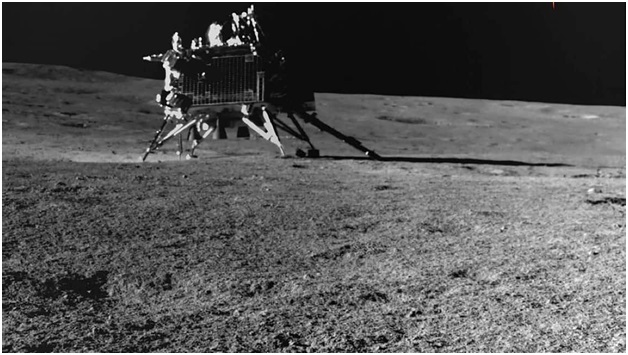Chandrayaan-3 | Vikram Hops on the Moon and Lands Safely (The Hindu)

- 05 Sep 2023
Why in the News?
Surpassing its intended mission goals, the Chandrayaan-3 mission's lander, Vikram, has reached a noteworthy milestone by successfully conducting a hop experiment.
Context:
- The Indian Space Research Organisation (ISRO) announced on Tuesday that the lander completed a successful hop experiment.
- Upon receiving the command, it activated its engines, lifting itself by approximately 40 cm as planned and made a safe landing within a range of 30–40 cm.
- This achievement in the hop experiment is of significant importance for upcoming missions, especially those aimed at retrieving lunar samples and future human expeditions to the moon. The lander module, which carried the rover Pragyan, had previously executed a successful soft landing on August 23. Following that, Pragyan was carefully deployed onto the lunar surface.
What is Hop Test?
- In the context of space exploratiom a "hop test" is typically refers to an experiment where a spacecraft's lander or rover briefly lifts off or hops above the surface of a celestial body, such as the moon or Mars, before landing back safely.
- This test is conducted to demonstrate the spacecraft's ability to perform controlled vertical takeoffs and landings.
- In lunar missions, for example, a hop test is crucial for various reasons:
- Mobility: Hopping allows the lander or rover to move to a different location on the lunar surface, providing it with increased mobility and access to a wider range of scientific targets.
- Avoiding Obstacles: Hopping can help the spacecraft avoid obstacles or hazards on the surface, such as large rocks or rough terrain.
- Positioning: Hopping can reposition the spacecraft's instruments or cameras for better observations.
- The successful execution of a hop test demonstrates the spacecraft's precision in controlling its engines, which is crucial for safe landings, mobility, and conducting experiments on celestial bodies with low or no atmosphere.
Post Hop Experiment Updates:
- ISRO reported that the spacecraft and its onboard instruments remained in excellent working condition after the successful 'hop.'
- Instruments such as the deployed ramp, ChaSTE, and ILSA were folded back and redeployed without any issues following the experiment.
- Subsequently, the payloads onboard the lander were deactivated in anticipation of the approaching lunar night.
- The solar-powered instruments were not designed to endure the extremely frigid temperatures of the lunar night, which can plummet to below -120 degrees Celsius.
- Therefore, the instruments on the rover were placed in a sleep mode a few days ahead of the start of the lunar night, which lasts for 14 Earth days.
- If the battery retains some charge during this period, the instruments can be reactivated when sunlight becomes available once more.
- Additionally, the ISRO Chairman announced plans to extend the mission life of both the lander and rover shortly after the launch of the Aditya-L1 mission.
- Originally, the mission life for both the lander and rover was set at just one lunar day, equivalent to 14 Earth days.
Why is the Hop Test Significant?
- Even though ISRO has not officially disclosed subsequent lunar missions, scientists believe that a sample return mission is a logical progression after Chandrayaan-3.
- In fact, had Chandrayaan-2 succeeded in 2019, Chandrayaan-3 would have been designed as a sample return mission.
- A human lander mission is also anticipated in the future.
- China's Chang'e lunar program has followed a similar trajectory, starting with an orbiter in 2007 and advancing to a lander and sample return mission (most recently in 2020).
- Therefore, the hop test holds critical importance for upcoming lunar missions. In missions involving sample return or human landings, the lander must take off from the lunar surface and return to Earth, necessitating much higher thrust.
- Nevertheless, as a technology demonstration, the 'hop experiment' remains a noteworthy achievement within the Chandrayaan-3 mission.
- The successful hop experiment also showcases India's prowess in space exploration, which could potentially attract international investments to the country's space endeavors.
